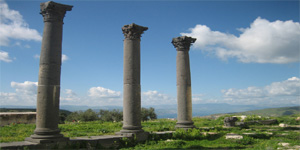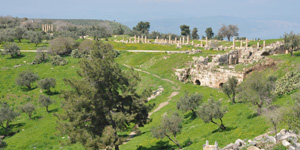|
Umm Quais, once known as Gadara, is a ruined Greco-Roman city, where visitors have an amazing view over the Sea of Galilee and the Golan Heights. Already mentioned in the Bible, in Umm Quais the famous miracle of the Gadarene swine took place. Jesus was healing a demoniac, cast the demons in a herd of swines which ran down into the Sea of Galilee (Mathew 8:28-34).
Since the 7th century BC Gadara was settled, due to the close location to trade routes between Syria and Palestine. First under Ptolemic, later Seleucid rule, the Roman took over in 63 BC. Gadara became a member of the Decapolis cities, renowned as a cultural centre with a cosmopolitan atmosphere. The poet Meleagros compared it even with Athens. It was the home of several classical poets and philosophers, including Theodorus, founder of a rhetorical school in Rome. Gadara continued to be a great and important city during Byzantine Christian times with a seat of a bishop. With the conquest of the Arabs, following the Battle of Yarmouk in 636, it came under Muslim rule. Largely destroyed by an earthquake around 747, the city was abandoned.
Umm Qais has impressive ancient remains, such as the stunning black basalt theatre with space for 3000 visitors, the basilica and adjacent courtyard strewn with carved black sarcophagi, the colonnaded main street and a side street lined with shops, an underground mausoleum, two baths and a Nymphaeum. Highlight is the view over 3 countries - Jordan, Israel and Syria. |


|